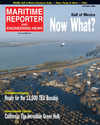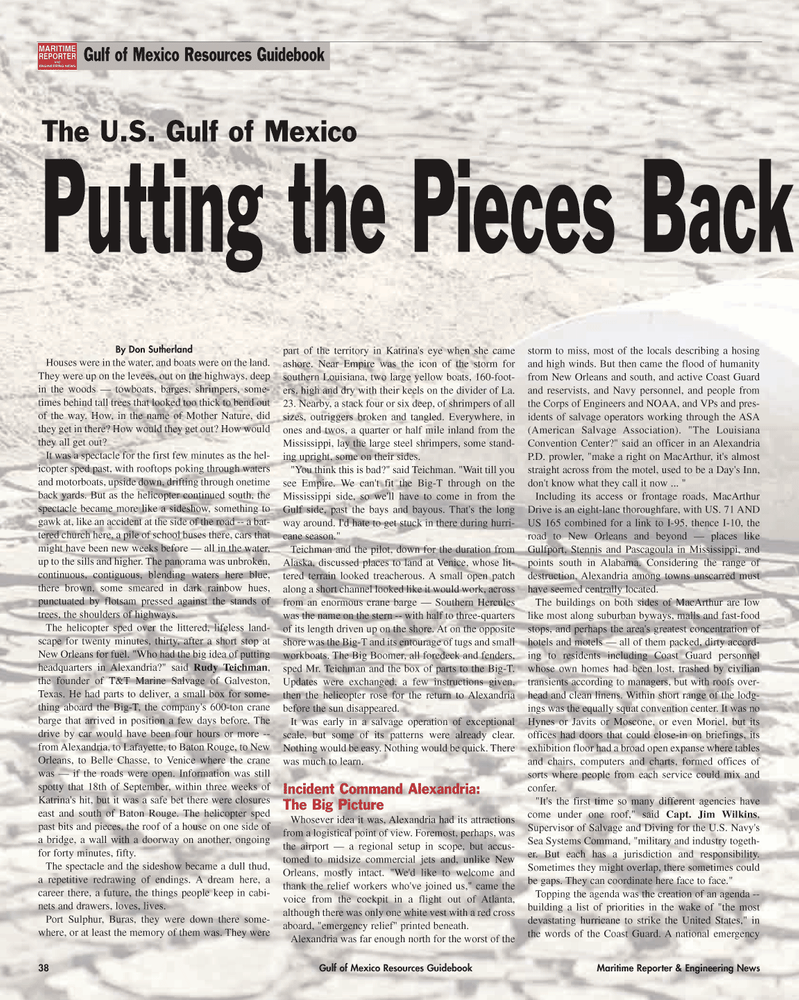
Page 38: of Maritime Reporter Magazine (November 2005)
The Workboat Annual Edition
Read this page in Pdf, Flash or Html5 edition of November 2005 Maritime Reporter Magazine
38 Gulf of Mexico Resources Guidebook Maritime Reporter & Engineering News
By Don Sutherland
Houses were in the water, and boats were on the land.
They were up on the levees, out on the highways, deep in the woods — towboats, barges, shrimpers, some- times behind tall trees that looked too thick to bend out of the way. How, in the name of Mother Nature, did they get in there? How would they get out? How would they all get out?
It was a spectacle for the first few minutes as the hel- icopter sped past, with rooftops poking through waters and motorboats, upside down, drifting through onetime back yards. But as the helicopter continued south, the spectacle became more like a sideshow, something to gawk at, like an accident at the side of the road -- a bat- tered church here, a pile of school buses there, cars that might have been new weeks before — all in the water, up to the sills and higher. The panorama was unbroken, continuous, contiguous, blending waters here blue, there brown, some smeared in dark rainbow hues, punctuated by flotsam pressed against the stands of trees, the shoulders of highways.
The helicopter sped over the littered, lifeless land- scape for twenty minutes, thirty, after a short stop at
New Orleans for fuel. "Who had the big idea of putting headquarters in Alexandria?" said Rudy Teichman, the founder of T&T Marine Salvage of Galveston,
Texas. He had parts to deliver, a small box for some- thing aboard the Big-T, the company's 600-ton crane barge that arrived in position a few days before. The drive by car would have been four hours or more -- from Alexandria, to Lafayette, to Baton Rouge, to New
Orleans, to Belle Chasse, to Venice where the crane was — if the roads were open. Information was still spotty that 18th of September, within three weeks of
Katrina's hit, but it was a safe bet there were closures east and south of Baton Rouge. The helicopter sped past bits and pieces, the roof of a house on one side of a bridge, a wall with a doorway on another, ongoing for forty minutes, fifty.
The spectacle and the sideshow became a dull thud, a repetitive redrawing of endings. A dream here, a career there, a future, the things people keep in cabi- nets and drawers, loves, lives.
Port Sulphur, Buras, they were down there some- where, or at least the memory of them was. They were part of the territory in Katrina's eye when she came ashore. Near Empire was the icon of the storm for southern Louisiana, two large yellow boats, 160-foot- ers, high and dry with their keels on the divider of La. 23. Nearby, a stack four or six deep, of shrimpers of all sizes, outriggers broken and tangled. Everywhere, in ones and twos, a quarter or half mile inland from the
Mississippi, lay the large steel shrimpers, some stand- ing upright, some on their sides. "You think this is bad?" said Teichman. "Wait till you see Empire. We can't fit the Big-T through on the
Mississippi side, so we'll have to come in from the
Gulf side, past the bays and bayous. That's the long way around. I'd hate to get stuck in there during hurri- cane season."
Teichman and the pilot, down for the duration from
Alaska, discussed places to land at Venice, whose lit- tered terrain looked treacherous. A small open patch along a short channel looked like it would work, across from an enormous crane barge — Southern Hercules was the name on the stern -- with half to three-quarters of its length driven up on the shore. At on the opposite shore was the Big-T and its entourage of tugs and small workboats. The Big Boomer, all foredeck and fenders, sped Mr. Teichman and the box of parts to the Big-T.
Updates were exchanged, a few instructions given, then the helicopter rose for the return to Alexandria before the sun disappeared.
It was early in a salvage operation of exceptional scale, but some of its patterns were already clear.
Nothing would be easy. Nothing would be quick. There was much to learn.
Incident Command Alexandria:
The Big Picture
Whosever idea it was, Alexandria had its attractions from a logistical point of view. Foremost, perhaps, was the airport — a regional setup in scope, but accus- tomed to midsize commercial jets and, unlike New
Orleans, mostly intact. "We'd like to welcome and thank the relief workers who've joined us," came the voice from the cockpit in a flight out of Atlanta, although there was only one white vest with a red cross aboard, "emergency relief" printed beneath.
Alexandria was far enough north for the worst of the storm to miss, most of the locals describing a hosing and high winds. But then came the flood of humanity from New Orleans and south, and active Coast Guard and reservists, and Navy personnel, and people from the Corps of Engineers and NOAA, and VPs and pres- idents of salvage operators working through the ASA (American Salvage Association). "The Louisiana
Convention Center?" said an officer in an Alexandria
P.D. prowler, "make a right on MacArthur, it's almost straight across from the motel, used to be a Day's Inn, don't know what they call it now ... "
Including its access or frontage roads, MacArthur
Drive is an eight-lane thoroughfare, with US. 71 AND
US 165 combined for a link to I-95, thence I-10, the road to New Orleans and beyond — places like
Gulfport, Stennis and Pascagoula in Mississippi, and points south in Alabama. Considering the range of destruction, Alexandria among towns unscarred must have seemed centrally located.
The buildings on both sides of MacArthur are low like most along suburban byways, malls and fast-food stops, and perhaps the area's greatest concentration of hotels and motels — all of them packed, dirty accord- ing to residents including Coast Guard personnel whose own homes had been lost, trashed by civilian transients according to managers, but with roofs over- head and clean linens. Within short range of the lodg- ings was the equally squat convention center. It was no
Hynes or Javits or Moscone, or even Moriel, but its offices had doors that could close-in on briefings, its exhibition floor had a broad open expanse where tables and chairs, computers and charts, formed offices of sorts where people from each service could mix and confer. "It's the first time so many different agencies have come under one roof," said Capt. Jim Wilkins,
Supervisor of Salvage and Diving for the U.S. Navy's
Sea Systems Command, "military and industry togeth- er. But each has a jurisdiction and responsibility.
Sometimes they might overlap, there sometimes could be gaps. They can coordinate here face to face."
Topping the agenda was the creation of an agenda -- building a list of priorities in the wake of "the most devastating hurricane to strike the United States," in the words of the Coast Guard. A national emergency
Gulf of Mexico Resources Guidebook
MARITIME
REPORTER
AND
ENGINEERINGNEWS
The U.S. Gulf of Mexico
Putting the Pieces Back T
MR NOVEMBER 2005 #5 (33-40).qxd 10/28/2005 9:34 AM Page 38

 37
37

 39
39
